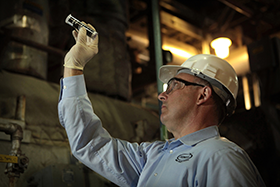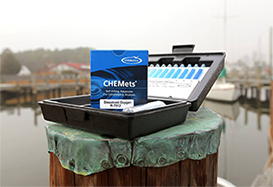Dissolved Oxygen

Visual Kits
| Range | MDL | Method | Type | Test Kit | Refill |
|---|---|---|---|---|---|
| 0 - 20 ppb | 2 ppb | Rhodazine D | ULR CHEMets | K-7511 | R-7511 |
| 0 - 40 ppb | 2.5 ppb | Rhodazine D | CHEMets | K-7540* | R-7540 |
| 0 - 100 ppb | 5 ppb | Rhodazine D | CHEMets | K-7599* | R-7540 |
| 5 - 180 ppb | 5 ppb | Rhodazine D | CHEMets | K-7518* | R-7518 |
| 0.0 - 1.0 ppm | 0.025 ppm | Rhodazine D | CHEMets | K-7501 | R-7501 |
| 1 - 12 ppm | 1 ppm | Indigo Carmine | CHEMets | K-7512 | R-7512 |
Photometric Kits
| Range | Method | Type | Test Kit | SAM Kit |
|---|---|---|---|---|
| 0 - 1.000 ppm | Rhodazine D | Vacu-vials | K-7553 | - |
| 0 - 15.0 ppm | Indigo Carmine | Vacu-vials | K-7513 | I-2002 |
The CHEMetrics test kits for the determination of Dissolved Oxygen (DO) in aqueous solutions are based on patented Self-Filling Reagent Ampoule technology, and employ the Rhodazine D & Indigo Carmine methods, delivering sensitivity and accuracy within two minutes or less. Premixed. Premeasured. Precise. Each kit contains 30 tests. Visual and instrumental DO testing kit formats span low and high measurement ranges. CHEMets® visual test kits use colour comparators for analysis while Vacu-vials® instrumental kits rely on CHEMetrics direct-readout photometers or spectrophotometers capable of accepting a 13-mm diameter round cell. Suitable for environmental testing as well as high-pressure boiler and deep well oil recovery equipment applications.
Rhodazine D™ Method

Test kits for boiler waters and applications requiring trace levels of DO (ppb range) employ the Rhodazine D methodology. Developed by CHEMetrics, and approved by ASTM as the reference method for ppb DO determination, the Rhodazine D compound in reduced form reacts with dissolved oxygen to form a bright pink reaction product. The method is not subject to salinity or dissolved gas interferences. Oxidising agents, including benzoquinone, can cause high results. Reducing agents such as hydrazine and sulphite do not interfere. Results are expressed as ppm (mg/l) or ppb (µg/l) O2.
Low-range dissolved oxygen test kits include a special sampling tube for use with boiler feedwater. This device allows the user to break the tip of the ampoule in a flowing sample stream in order to preclude error from contamination by atmospheric oxygen.
Click here for more information on CHEMetrics ppb Dissolved Oxygen test kits.
* The Rhodazine D Test Kits K-7540, K-7599 and K-7518 can optionally be used with the CHEMetrics Comparator Light Source (CLS) for low-light conditions.
References:
Developed by CHEMetrics.
ASTM Power Plant Manual, 1st. ed. p. 169 (1984).
ASTM D 5543-09, Low Level Dissolved Oxygen in Water.
Department of the Navy, Final Report of NAVSECPHILADIV Project A - 1598, Evaluation of CHEMetrics Feedwater Dissolved Oxygen Test Kit (1975).
|
|
Technical Data Sheet |
Indigo Carmine Method

Test kits for environmental and drinking water applications (ppm range) employ the indigo carmine method. The reduced form of indigo carmine reacts with DO to form a blue product. The indigo carmine methodology is not subject to interferences from temperature, salinity, or dissolved gases such as sulphide, which plague users of DO meters. Results are expressed as ppm (mg/l) O2.
References:
ASTM D 888-87, Dissolved Oxygen in Water, Test Method A.
Gilbert, T. W., Behymer, T. D., Castañeda, H. B., "Determination of Dissolved Oxygen in Natural and Wastewaters," American Laboratory, March 1982, pp. 119-134.
|
|
Technical Data Sheet |
Applications
High-Pressure Boilers & EOR Equipment
At elevated temperatures, oxygen is highly corrosive to metals, causing pitting in ferrous systems such as high-pressure boilers and deep well oil recovery equipment. To prevent costly corrosion damage, the liquids in contact with the metal surfaces must be treated, usually by a combination of physical and chemical means. Deaeration can reduce the dissolved oxygen concentration of boiler feedwater from several ppm to a few ppb. Chemical reducing agents such as hydrazine, DEHA, or sodium sulphite, may be used instead of or in conjunction with deaeration.
Click here to view our Monitoring Dissolved Oxygen in High-Pressure Boiler Systems & Feedwater application overview article.
Environmental Monitoring
The level of DO in natural waters is often a direct indication of water quality. Oxygen depletion occurs when DO consumption exceeds rates of O2 production within the water and diffusion into the water. Insufficient DO will may inhibit the natural decomposition of organic matter, resulting in a gradual build up of organic matter. Low DO in natural waters may be a result of natural processes or low DO levels in waste treatment plant effluent.
DO in natural waters comes from atmospheric oxygen and daytime photosynthesis by aquatic plants, turning CO2 into O2. Air pressure and water temperature affect how much O2 can be absorbed from the atmosphere as well as the action of water movement, turbulence and wind. DO is used up in natural waters by fish through their gills as well as by microorganisms as they feed on contaminants and pollutants, e.g. decomposition of organic matter (Francis-Floyd, 2003). The action of the above mechanisms results in a continuously shifting equilibrium.
At low temperatures the solubility of oxygen is increased; during the summer, saturation levels can be as low as 4 ppm. 100% O2 saturation at 25°C is 8.26 ppm. 100% saturation at 0°C is 14.6 ppm (Water Rangers, 2022). Ice covering a water body will prevent any new atmospheric O2 dissolving.
The amount of dissolved oxygen needed to support aquatic life varies between species. In seawater, bottom feeders, shellfish and worms require only 1 - 6 ppm O2. Only a few fish and aquatic insects can survive with less than 4 ppm O2. Shallow water fish require typically between 4 - 15 ppm.
Waste treatment plants that employ aerobic digestion must maintain a level of at least 2 ppm dissolved oxygen.
What is Oxygen?
Oxygen, a.k.a. dioxygen, is a colourless, odourless gas with the chemical formula O2 or O=O. The diatomic oxygen molecule consists of two oxygen atoms joined together by two covalent bonds. Oxygen is a highly reactive oxidising agent, especially at high temperatures and pressures, forming oxides with many elements and compounds in a process known as corrosion or oxidation, e.g. rust. Oxygen is required for cellular respiration of animals, plants and fungi, as well as aerobic decomposition. Oxygen comprises 21% of the atmosphere and all water contains atmospheric gases including oxygen. The oxygen atom (O) does not occur in its free state in nature, but is found as dioxygen and ozone gas, as water, snow, ice and water vapour, and in the Earth's crust in the form of oxides.